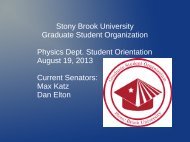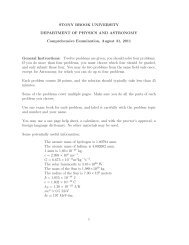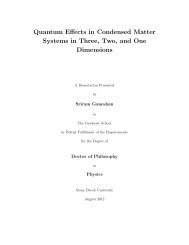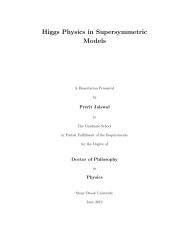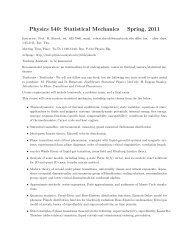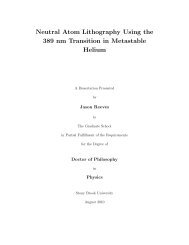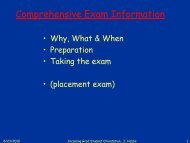Theory of Nuclear Matter for Neutron Stars and ... - Graduate Physics
Theory of Nuclear Matter for Neutron Stars and ... - Graduate Physics
Theory of Nuclear Matter for Neutron Stars and ... - Graduate Physics
You also want an ePaper? Increase the reach of your titles
YUMPU automatically turns print PDFs into web optimized ePapers that Google loves.
Since the mass <strong>of</strong> neutron star is dominated by its core <strong>and</strong> the density <strong>of</strong> the core is muchbeyond the nuclear saturation density, the nuclear <strong>for</strong>ce models should be investigated morethan the current level <strong>of</strong> underst<strong>and</strong>ing.In contrast to neutron stars, supernovae explosions <strong>and</strong> neutron star mergers result in extremelyhigh temperature. Thus, we need to know thermodynamic properties <strong>of</strong> nuclearmatter <strong>for</strong> a wide range <strong>of</strong> densities (10 −9 ∼ 1.6/fm 3 ) , temperature (0 ∼ 30 MeV), <strong>and</strong>proton compositions (0 ∼ 0.56). This thesis concerns nuclear physics under such extremeconditions, which are far beyond those achievable by nuclear physics experiments on earth.Hence, a theoretical extrapolation is needed <strong>for</strong> high density, high temperature, <strong>and</strong> low protonfraction. For zero temperature, the extrapolation <strong>of</strong> nuclear properties at high densitydensity ( 10ρ 0 ) can be checked by the mass-radius relation <strong>of</strong> neutron stars [53]. Un<strong>for</strong>tunately,the extrapolation to high temperature cannot be checked with anything fromexperiment or astrophysical observations at this time.The nuclear thermodynamic in<strong>for</strong>mation is called ‘<strong>Nuclear</strong> Equation Of State’ (EOS) <strong>and</strong>provided as a tabulated <strong>for</strong>m because <strong>of</strong> memory constraints. The table should contain freeenergy density, pressure, entropy as a function <strong>of</strong> baryon number density, proton fraction,<strong>and</strong> temperature.For the simulations <strong>of</strong> supernovae explosions, only a few EOS tables available now. The mostfamous one is Lattimer & Swesty [22] (LS) EOS in which they combined non-relativistic potentialmodel with liquid droplet approach. In their EOS they considered phase transitionsfrom three dimensional nuclei to three dimensional bubble. It is difficult in their code toarbitrarily vary nuclear parameters.H. Shen et al. [59] (STOS) built a table using relativistic mean field model (RMF) <strong>and</strong>Thomas Fermi approximation. To per<strong>for</strong>mthe Thomas Fermi approximation, they employedthe parametrized density pr<strong>of</strong>ile method, in which density pr<strong>of</strong>ile follows a mathematicalpolynomial (see chapter 5) so to avoid the numerical difficulty <strong>of</strong> differential equations. Anew version [60] is available now <strong>and</strong> it contains hyperon interactions.G. Shen et al. [61] (SHT) provided a few version <strong>of</strong> tables using RMF parameter sets. Theyemployed the Hartree approximation to find the nuclear density pr<strong>of</strong>ile. It is difficult <strong>and</strong>very time consuming to develop another table using their code. Table 1.1 show the range <strong>of</strong>Table 1.1: Range <strong>of</strong> TablesLS 220 STOS SHTρ(fm −3 ) 10 −6 ∼ 1 (121) 7.58×10 −11 ∼ 6.022 (110) 10 −8 ∼ 1.496 (328)Y p 0.01 ∼ 0.5 (50) 0 ∼ 0.65 (66) 0 ∼ 0.56 (57)T (MeV) 0.3 ∼ 30 (50) 0.1 ∼ 398.1 (90) 0 ∼ 75.0 (109)the independent variables <strong>and</strong> the number <strong>of</strong> grid points (number in the parenthesis). STOStables deals wide range <strong>of</strong> densities <strong>and</strong> temperature. The number <strong>of</strong> grid points, however,is small so that the interpolations from that table might not be suitable <strong>for</strong> the simulation,which needs high thermodynamic consistencies. That is, except <strong>for</strong> the LS EOS, the pressure<strong>and</strong> entropy densities from STOS <strong>and</strong> SHT are obtained from the numerical derivatives(P = −ρ 2∆F,S = ∆ρ −∆F ). But this numerical <strong>for</strong>malism might not give enough accuracy <strong>for</strong>∆T3



